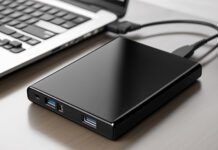The Shure Beta 58 has the added advantage of having a titanium ball cover, which means you can drop the darn thing and never have a dented ball cover. You can drop the SM57/58s on the floor, from the stage, and probably run them over with a truck and they’ll keep working.
But don’t drop them. Just because you can, doesn’t mean you should. (But you already know that, don’t you?)
Drum microphones
In small church sound gear components, I usually recommend miking only the kick drum and the snare. I’ve found many small churches don’t have a big room, and the rooms they do have are very “alive.” Now, if the room is really dead or the room is huge, then use all four mics. Use Shure SM57′s for snare and toms and a Shure Beta 52A on the kick. Use a condenser for an overhead mic.
Instrument microphones
A combination of dynamics and condensers are good for instrument miking. Most of this type of miking will be for a piano or a drum kit. Other gear, like guitars and keyboards, plug directly into the system. A Shure SM57 is a good dynamic microphone and commonly used for snare drum miking.
Microphone cables
No matter what you’ve heard, don’t go spending $50 for a Mogami or Monster mic cable. Go to monoprice.com and pick up their mic cables for peanuts. They’re lifetime warranted and just as good as anything out there.
Wireless headset microphone
You get what you pay for. Have I said that already? Spend under $500 for something other than a Shure, Sennheiser or Audio-Technica wireless system, with a headset mic, and the regret might soon set in. A wireless system from any of the “big names in high-quality microphones” will be good. I’ve just listed a couple in case you’re new to buying equipment.
Quality counts in the wireless arena and high quality isn’t cheap. Look for something in the UHF or digital frequency range. Stay away from anything in the 680-850mhz range if you are in the USA. As of July 1, 2010, this frequency range is no longer available for wireless mic use. You should not see them in the stores, but watch for “a great deal on eBay” because it’s not a great deal.
Also, in this price range for sound gear components, models are frequency-agile. This means they have dual antennas and can skip back and forth between frequencies to get the best signal.
Power conditioner
Spend a little bit (around $100) for a Furman power conditioner to protect the “really” expensive equipment. Furmans are built for protecting audio and computer equipment. They are also built like a tank.
Don’t buy a $15 power strip and expect it to protect gear the same way. It won’t. I have a standing rule. Anything that plugs in at the sound booth gets plugged into a Furman, or it doesn’t get plugged in.
Furmans are designed to sacrifice themselves in the event of a power surge. This means spending another $100 for a replacement if it gets fried, but the rest of your equipment will have been protected. Plus, they have a replacement guarantee on the remaining equipment if the Furman doesn’t do its job.
Sound Gear: It’s a wrap
That’s it in a nutshell—a very big nutshell of sound gear components. Post a comment below if you have questions about your situation or thoughts on this list.











